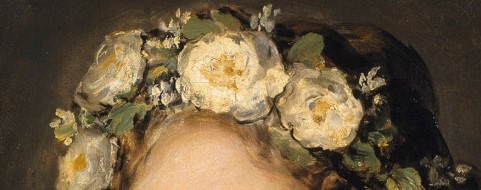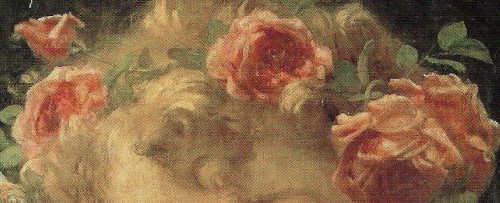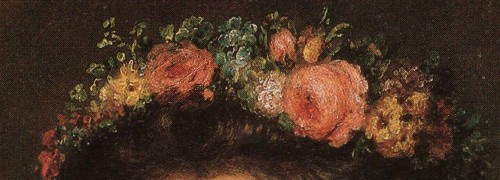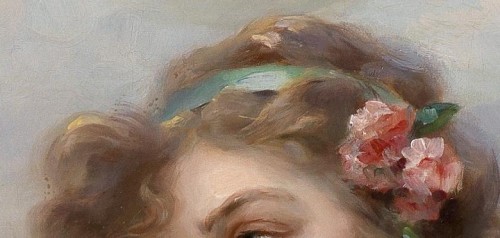You Will Patch Up All The Holes In 2025.
You will patch up all the holes in 2025.
(this isn’t a post about knitting)
More Posts from Scrapbox-in-the-attic and Others
“Where should I host my webcomic?”
If you’re making a new webcomic it’s often difficult to decide where to put it, especially since if you need this kind of resource you’re probably just starting out. So, here’s some info I’ve gathered on some popular hosting platforms and their benefits/downsides. I’m not an artist, so this isn’t an inside scoop, but I’ve put some research into this and I know what artists have said about their experiences. All of these platforms are free and public to use unless noted otherwise.
Tapas (aka Tapastic)
Tapas is a website and app that is made for hosting webcomics.
Example - Example
Benefits:
VERY well known, one the most popular hosting platforms around.
It’s mostly set up so users check out as many comics as possible -> easier time attracting readership.
Once you start getting subscriptions it starts figuring out what other comics get similar readership. It’ll start recommending your comic and you’ll get more consistent readers.
It’s very easy to use and smoothly designed. Pefect for new artists.
There’s kind of a social aspect to it? I don’t know how to describe it. Every user has a page you can comment on and there’s a robust comment system on pages/episodes.
TAPAS TIPPING. A brilliant, original system. Users can watch ads for “tapas coins”, which they can “tip” towards their favorite artists! This turns into free real money for you. You can also apply to tapas premium to make a comic or novel that’s unlocked per episode with coins. (novels are only acessible on the tapas app, which it seems to be moving towards)
Downsides:
It’s very reader-centered. Not so much on artists.
In fact it recently tried a really sketchy move where it added a clause to its terms of service potentially restricting where else artists could post even the free comics. It was later removed after sitewide backlash and mass comic removal.
No control over how your website appears. You get to make a banner and an icon, that’s it. This could be a good thing, since you don’t have to worry about it and its theme works very well.
Sometimes it’s a little buggy. I’ve noticed a lot of artists post with links to other platforms and apologies because it won’t let them add an update.
How to Join:
Create a free account.
Create your comic.
LINE Webtoon
Example - Example
Webtoons is a free website and app for hosting webcomics.
Benefits:
Similar to Tapas, but with a more high-class feel.
(By that I mean I see very few debut artists and more professionals there.)
It’s about as easy to use, and it’s becoming much more well-known, especially after the mass exodus to Webtoons after the Tapas TOS incident. They also advertise comics on others’ pages with similar readership, but it’s kinda skewed towards comics that already have a lot of readers. I get the feeling that it’s focused on providing a good experience for its users more than reading a lot of comics.
You still cannot control how your site works, but again, what they give you is very good.
Every month the staff chooses some comics to become “featured” artists. Featured Artists make $2000/month as long as they don’t post on any other webcomic sites. As the name implies, they also advertise you more. They really like to mention this benefit.
Downsides:
You might not get any traffic? Mostly the biggest problem is just having to use its framework which is designed for webcomics.
How to Join:
Create a free account.
Create your comic.
Smackjeeves
Example - Example
Smackjeeves is yet another free host for webcomics.
Benefits:
You get a subdomain automatically, which you can heavily customize the appearance of.
It has a very social format compared other hosts.
Smackjeeves also recommends comics, but not on other comics’ pages. You can explore comics throughtout the site.
Downsides:
I personally find the website very confusing. I can’t imagine it’s much better on the artist side of things.
How to Join:
Create a free account.
Create your comic.
Tumblr
Example - Example
You’re on it! Tumblr is a social media platfrom that is based on users having one or more blogs to create streams of posts with.
Benefits:
Tumblr blogs already have a “page” format for scrolling through chunks of posts. Just set your post per page ratio to one and voila! Already looks very similar to actual webomic sites.
One of the highlights of Tumblr as a social media platform is being able to manually edit your blog’s HTML. There are even publicly available user-made themes for webcomics.
It’s a social media platform! It’s very easy to interact with your fanbase.
A lot of webcomic fans use Tumblr - it’s well-suited to fandom in particular.
Your updates would in reality be posts on a blog. Readers might reblog them and share your work with other people. It’s by far the best platform for word-of-mouth advertisement.
If you’re reading this you probably already know how to use it.
Downsides:
Tumblr is just … not made for webcomics. At all.
Archiving in particular is very counterintuitive for webcomics. Page urls are not static - “page 2” is the second-most recent update, not the second page. In order to find an individual update you have to actually page back to it or scroll through the default uneditable archive.
How to Join:
Get a free account.
If you already have one, you can simply create a sideblog. But you might want a whole account just for the comic - outgoing likes and asks show up as your main blog, so if you’re using a sideblog it exposes your personal/main blog whenever you interact with fans.
Edit your blog’s theme extensively.
Begin posting your updates.
Custom Website
Example - Example
No external host. Make your own website, just for your comic!
Benefits:
ABSOLUTE CONTROL. You decide how it looks, how it works, and what features it has. Most webcomic sites have similar formats: prominent centered pages (and usually the current update on the “main” page), first/previous/next/recent buttons, an archive, an about page, information on when it updates, etc. But in general everything is 100% up to you.
I cannot stress that ^^^ enough.
No license or restrictions of any kind. Except, like, laws. Obviously.
Many features are easy to add to your website. Disqus (Insertable commenting platform. Sorta structured like Reddit) is getting more and more popular and I haven’t heard anyone mention it costing anything.
You can get ad revenue from your site, and 100% of it goes to you.
Downsides:
Unless you have the skills to make a functional professional website on your own, it costs money. Plus, there’s the relatively small monthly/yearly cost of reserving a domain name.
Finicky and difficult to fix problems. When Tapas eats your update, you wait a day or two before it works again. When the commenting system disappears, you have to call whoever made your website or fix it yourself.
There’s no real way of attracting readership (and ad revenue!) other than word-of-mouth or paying for ads. No handy recommendation system in place. This is ONLY a move for someone who already has a guaranteed reader base. However, almost every popular comic artist eventually gets their own site so it must be worth it past a certain threshold.
How to Join:
Get a domain name and a website.
Post your comic on your new website.
Advertise the heck out of it.
SpiderForest
Example - Example
SpiderForest is a collective of comic artists, not a public service. You must apply to join.
Benefits:
The application process isn’t very strict; it’s there so that it isn’t flooded with low-quality comics. Not sure how I feel about it but it works pretty well for them.
You get the benefits of any vetted group. They advertise you on their main site, and being a member adds credibility to your work.
Even though it is an exclusive group, its policy allows unlimited mirrors, so you can still use anything else you want.
Downsides:
In order to be a member you have to have at least one mirror on a custom site they can link to or host directly on their site. Not much of a downside but still.
Your comic should already exist somewhere else. They generally won’t approve pitches for potential projects, unless you’re already an established creator with previous work to show instead.
It’s not as well known? It’s still pretty high up there.
How to Join:
Apply using the link at the top of their main page.
Be accepted.
Post your comic on your associated Spiderworks site.
Hiveworks
Example - Example
Hiveworks is a for-profit professional organization. You don’t ask to be a member, Hiveworks asks you to join. There’s like a 95% chance you should SAY YES.
Benefits:
Hiveworks gives you a free website (see: custom website benefits)
All Hiveworks sites have a little sidebar advertising other hiveworks comics. They also advertise your comic on their main aggregate site.
They look for good comics, it’s their job. Having their logo on your site is a testament to the quality of your work. You’ll get so many readers and comissions, trust me on this one.
Downsides:
You do have to provide some art to them. They’ll sell merch of your comic (which you get a large cut of!), and you need to provide icons and banners for them to advertise you with. When they do well, you do well, and vice versa.
If you are a member you cannot host your comic any new sites, especially their biggest competitor, SpiderForest. This contract lasts a while. Sometimes you get to keep your existing ones, though.
^^ Contracts. There’s still the tiniest bit of risk, but it’s a reputable organization.
How to Join:
Be asked to by Hiveworks.
Negotiate a contract.
This is all of the things I have been able to learn as a reader. If one or more of them sounds promising for you, try and send a message asking an artist who uses these platforms for what they think. Good luck!
Writing a Blind or Visually Impaired Character
A Multi-Step Guide Written by a Visually Impaired Writer and Blogger
I’m hoping this blog will over time develop its own following, and when it does people will inevitably see my bio and notice what I included: I’m visually impaired.
Yes, a visually impaired writer, and I’ve written with two blind characters before so I have some practice in the field.
So, inevitably, someone is going to ask how to write a blind character.
Or, at least, I hope you’ll ask someone who’s actually blind or visually impaired about writing a blind character before you get too involved with your new WIP.
All parts will be tagged #blindcharacter in my blog, and I will add links to every post as I finish each part. Follow my blog for more writing advice.
Note, this post updates fairly often and old versions are still floating around out there. The most current version of this post is pinned to my blog with any new guides or links you might of missed.
As of 29 June 2022, this is the most extensive and screen reader friendly version of this post.
Part One: Crafting the Blind Character
In which I tell you how to begin making a blind character who is more than a cardboard cutout
Part Two: Narrative Choice, Visual Description, Verbal Description, Social Interaction
In which I give you a basic rundown on how to write from the perspective of a character who can’t see and still make the narration descriptive
Part Three: Tropes and Clichés to Avoid
Your blind readers will thank you for not being the 5000th person to do this and manage to actually finish your story. (Do you have any idea how many stories I’ve noped out of within two chapters because of these clichés? A Lot.)
Part Four: Canes, Guide Dogs, and O&M
Everything I can tell you about 1) how to learn how to use a cane 2) how a cane works 3) how to describe what your character experiences with their cane 4) everything I know on guide dogs
-New- Additional Advice for Writing Sighted Guides–another legitimate form of O&M
Part Five: Small Aspects of being Blind You Never Thought Of
5 January 2021 Edit: This link has been fixed to correspond with the correct post
Or, really, very normal everyday things for blind people, the inclusion of which will make your characters more real and authentic. It’s the tiny details.
Part Six: Should You Cure Your Character’s Blindness? (Short Answer: No)
There’s no way to write a cure for your blind character that doesn’t make blind readers hate you. Sorry. We came here to finally experience a relatable character who experiences the world like us, but none of us are getting cured so seeing this character we learned to love become something alien from us in the end feels like a slap in the face
-New- What about a Temporary Cure to Show the Character is Happy being Blind?
Why I’m Blind and What I See -NEW-
I thought I’d finally make a post explaining the complicated situation about my vision. Includes an explanation of visual snow and exotropia, two of the three causes for my vision issues.
Writing Blind Characters Falling in Love, an Advice Post:
Someone asked what being blind and falling in love have to do with each other. Honestly, blindness changes your perspective on everything and it makes an impact on every relationship you have. This includes some things that you definitely do not want your character’s love interest to be/do.
Writing Blind Jokes (Should You Do It?)
You know those flow charts of “should you do x?” going around? It’s like that, but screen reader friendly. Should you write blind jokes. It’s pretty complicated and there are a lot of possible scenarios and details to consider.
Advice for Writing Toph Beifong -NEW-
In this I discuss what I would like to see done in fanfiction with Toph’s character after ten years of reading Avatar the Last Airbender fanfiction
-New- Some Informal Thoughts About Toph and ATLA World Building based on a Throw-Away Line
A small essay addressing the frequently asked question on giving your blind character a superpower to help them “see.”
It’s became a popular question, so to make the answer easier/faster for everyone to access, I wrote what will usually be my initial answer. Below there are a few links to some notable past questions on this subject.
Mourning My Vision, it’s More than Depression.
A small personal essay addressing the nuances of the mourning period you experience with a new disability. The mourning period is mentioned in other guides, but this is more detailed.
Dealing with Heightened Senses, a video by Molly Burke with additional commentary by me
While Molly talks about the myths and truths about heightened senses, I talk about the correlation with blindness and neuro-divergency and how co-morbid disorders/disabilities might affect sensory processing.
Satirical Commentary on the phrase “that blank look in their eyes” used too often in fiction to identify a blind character
a:tla, I’m looking at you (and my eyes aren’t blank)
I Found a Lost Piece of Blindness History
My grandmother told me about her blind aunt and how she sent letters. It led me to speculate about all the O&M things people develop on their own but never get a chance to pass onto other blind people. Technology and techniques are lost in history and reinvented, including the white cane ad guide dogs.
Includes a little history on the introduction of guide dogs into the 20th century
The Following are Answered Anon Questions
Making Your Blog More Accessible
Making Links Accessible to Screen Readers
Reblogging to Add an Image Description to Someone Else’s Image
Why I Write Image Descriptions
Terms, Definitions, and Practical Advice
-New- What is the difference between Light Perception and Shadow Perception
Writing Blind Characters
Advice for a Character Who was Born Blind
-New- A More Recent Post about Characters Born Blind
Over-Protective Parents of a Blind Character, Why They’re Over-Protective and How to Avoid Crossing a Line
A Blind Character in Victorian Era Historical Fiction
Is It Bad Not to Have Guide Dogs in a Fantasy/Historical Setting Without Guide Dogs (short answer: it’s not bad)
Someone Asked About My Thoughts on a Medusa-like Character Blinding Herself to Avoid Hurting Anyone
-New- Someone Asked For Advice Writing a Character whose Eyes were Gouged Out–and Why Blindfolds are Not a Good Idea + Medical Alternatives
Characters Who Have Recently Gone Blind and Avoiding Inspiration Porn
-New- Inclusive Language in Dialogue: Is it appropriate for a blind character to use visual verbs like “I saw” and “I watched”
-New- Thoughts on If Characters Would Drink and Go to Bars
(In one of my original guides I said I was sure most blind people would not go to bars. A few years later, I’ve now realized that sentiment is influenced by my gender, not my disability.)
-New- Researching Blind Historical Figures
I took a disability studies class focusing on Helen Keller’s complicated legacy. My professor gave us the option to get creative with our final projects, so I gathered all the research I had for three blog posts.
How did Helen Keller Navigate her World
My extensive historical research on the accessibility tools Keller had in her lifetime
Who was Helen Keller: Her Passions and Interests
I talk about her writing, her politics as a socialist and suffragette, her love for animals and nature, her brief history as a performer on stage, and how she became the face for Blind Advocacy. This includes lots of photos of Keller with image descriptions I wrote.
The Controversies Surrounding Helen Keller
-This includes:
Her family history as the daughter of a Confederate Captain
Growing up on a plantation that formerly held slaves
How she met Alexander Graham Bell and the negative influence both had on the Deaf community
Her sexuality and falling in love (and why that was so controversial)
Her stance on eugenics and her internalized ableism
The Miracle Worker (1963) movie- how it became the most popular depiction of Keller, why it’s problematic, and how it damaged her legacy
The 2020 TikTok Controversy and #HelenKellerwasfake
Talking about Popular Blind Characters In Media
Does Daredevil’s Echolocation Negate His Blindness
-New- Is it Worth it to Watch All of Daredevil for the Research (It’s Not)
Someone Else was Asked How to Write Daredevil Fanfiction
Blind Characters with Superpowers/Fighting Styles
World Setting where the General Population has a Superpower
Superpowers that don’t involve sight, Five questions to ask yourself if this superpower is a bad idea or a good one
-New- Your character would not use a cane as a weapon, it’s a bad idea
D&D/Roleplaying Blind Characters
-New- Animal Familiars Acting as Service Animals and Advice for Communicating with Your DM
-New- Portraying Older Blind Characters + Causes for Vision Loss with Old Age


I’ve had a HELL of a day trying to figure out skulls and facial structure, but here’s some stuff I did about proportions and shading and coloring. Face structure was referenced from this,
Shading locations I actually picked up from a thing that’s about makeup I’m pretty sure, but it gave some good results so I rolled with it. And the info on hue in faces are what I applied from this post. Gives the skin some more natural glow? Play around with settings and stuff.
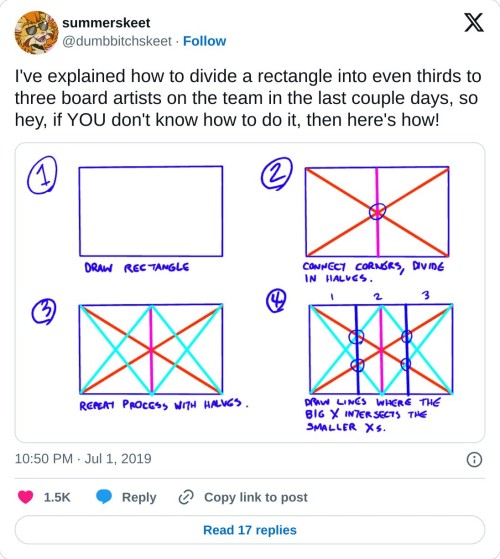
really helpful technique ^ once you know how to divide by halves and thirds it makes drawing evenly spaced things in perspective waaay easier:



got a couple of questions askin for tips, here you go my babas Still have a lot to learn myself, lets go on this journey togetherrr

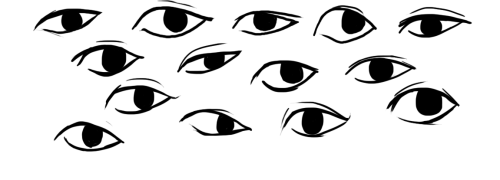
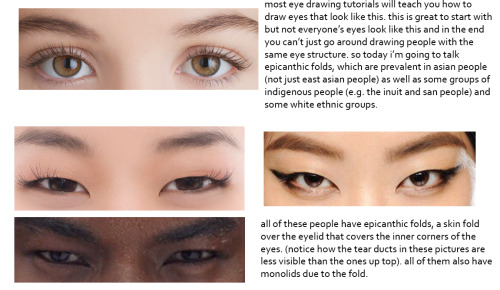
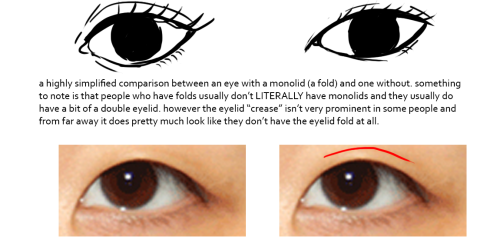

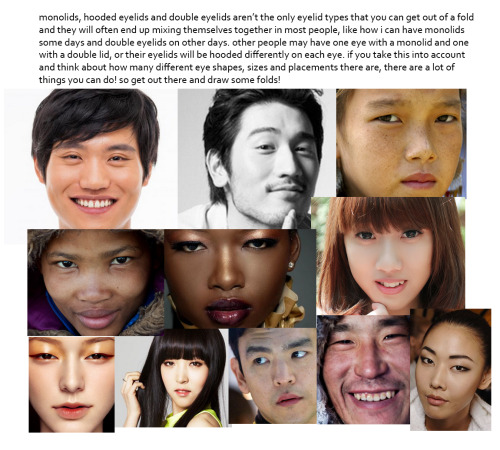
this was gonna be a tutorial and i guess it still is but if anything it’s just a really long and drawn out “essay” on drawing people with epicanthic folds. one of my biggest pet peeves is people drawing asian people exclusively with the same type of eye they’d give white people or anyone else who typically doesn’t have the fold! however i know that most people are taught with the standard white person eye (google image search for “eye” and it’ll all be pictures of white people’s eyes) so learning to draw epicanthic folds is a consciously learned thing.
therefore i bring you this, which attempts to break the mechanics of epicanthic folds down into something that’s a bit easier to digest and implement in your own art!
style can be argued i guess but it’s not that hard to stylize eyes with folds if you do proper observation and research. eyes with epicanthic folds are as diverse as eyes without so it’s not like you have to adhere to a strict model for them (although many people think that you have to) and all it takes to distinguish the two in stylized art (and even in semi/realism once you think about it) is a few lines! like i said this is a learned process but it’ll make your asian characters (and characters of other races even) a bit more interesting and believable.
-
 truly-kakegurui reblogged this · 1 week ago
truly-kakegurui reblogged this · 1 week ago -
 truly-kakegurui liked this · 1 week ago
truly-kakegurui liked this · 1 week ago -
 clementine-elegance reblogged this · 1 week ago
clementine-elegance reblogged this · 1 week ago -
 aerilayasiorra liked this · 1 week ago
aerilayasiorra liked this · 1 week ago -
 asirenbyanyothername liked this · 1 week ago
asirenbyanyothername liked this · 1 week ago -
 attacadabra liked this · 1 week ago
attacadabra liked this · 1 week ago -
 inonalisa liked this · 1 week ago
inonalisa liked this · 1 week ago -
 piekhana reblogged this · 1 week ago
piekhana reblogged this · 1 week ago -
 silent-reply reblogged this · 1 week ago
silent-reply reblogged this · 1 week ago -
 silent-reply liked this · 1 week ago
silent-reply liked this · 1 week ago -
 omgdontpeekcreep liked this · 1 week ago
omgdontpeekcreep liked this · 1 week ago -
 jailhousesmile liked this · 1 week ago
jailhousesmile liked this · 1 week ago -
 ohbeffinitely liked this · 1 week ago
ohbeffinitely liked this · 1 week ago -
 mm--eli liked this · 1 week ago
mm--eli liked this · 1 week ago -
 cherryveri liked this · 1 week ago
cherryveri liked this · 1 week ago -
 boydemon94 reblogged this · 1 week ago
boydemon94 reblogged this · 1 week ago -
 boydemon94 liked this · 1 week ago
boydemon94 liked this · 1 week ago -
 luna177 liked this · 1 week ago
luna177 liked this · 1 week ago -
 luna177 reblogged this · 1 week ago
luna177 reblogged this · 1 week ago -
 alphafornacis liked this · 1 week ago
alphafornacis liked this · 1 week ago -
 livinglucidwithlexi reblogged this · 1 week ago
livinglucidwithlexi reblogged this · 1 week ago -
 livinglucidwithlexi liked this · 1 week ago
livinglucidwithlexi liked this · 1 week ago -
 ghev13 liked this · 1 week ago
ghev13 liked this · 1 week ago -
 chuletablues liked this · 1 week ago
chuletablues liked this · 1 week ago -
 glowglowcloud liked this · 1 week ago
glowglowcloud liked this · 1 week ago -
 anoki liked this · 1 week ago
anoki liked this · 1 week ago -
 logiqcareers liked this · 1 week ago
logiqcareers liked this · 1 week ago -
 lumps-42 liked this · 1 week ago
lumps-42 liked this · 1 week ago -
 bubzila-gem reblogged this · 1 week ago
bubzila-gem reblogged this · 1 week ago -
 thesilly-goose reblogged this · 1 week ago
thesilly-goose reblogged this · 1 week ago -
 thesilly-goose liked this · 1 week ago
thesilly-goose liked this · 1 week ago -
 missvanta-xoxo reblogged this · 1 week ago
missvanta-xoxo reblogged this · 1 week ago -
 undertheskin13 liked this · 1 week ago
undertheskin13 liked this · 1 week ago -
 serahblue liked this · 1 week ago
serahblue liked this · 1 week ago -
 craftcrone liked this · 1 week ago
craftcrone liked this · 1 week ago -
 sophistikitten liked this · 1 week ago
sophistikitten liked this · 1 week ago -
 lostinspacelesbian liked this · 1 week ago
lostinspacelesbian liked this · 1 week ago -
 dhmis-doi liked this · 1 week ago
dhmis-doi liked this · 1 week ago -
 m4rym4gd4lene liked this · 1 week ago
m4rym4gd4lene liked this · 1 week ago -
 mosamoth liked this · 1 week ago
mosamoth liked this · 1 week ago -
 funkynoshes liked this · 1 week ago
funkynoshes liked this · 1 week ago -
 filmbro liked this · 1 week ago
filmbro liked this · 1 week ago -
 queenofthebees liked this · 1 week ago
queenofthebees liked this · 1 week ago -
 wheremstarethememes liked this · 1 week ago
wheremstarethememes liked this · 1 week ago -
 onewingedplatypus reblogged this · 1 week ago
onewingedplatypus reblogged this · 1 week ago -
 elfquestisbest liked this · 1 week ago
elfquestisbest liked this · 1 week ago -
 vatusia liked this · 1 week ago
vatusia liked this · 1 week ago -
 boomingfiend liked this · 1 week ago
boomingfiend liked this · 1 week ago -
 2ndgengeek liked this · 1 week ago
2ndgengeek liked this · 1 week ago -
 pastel-bimbo liked this · 1 week ago
pastel-bimbo liked this · 1 week ago

